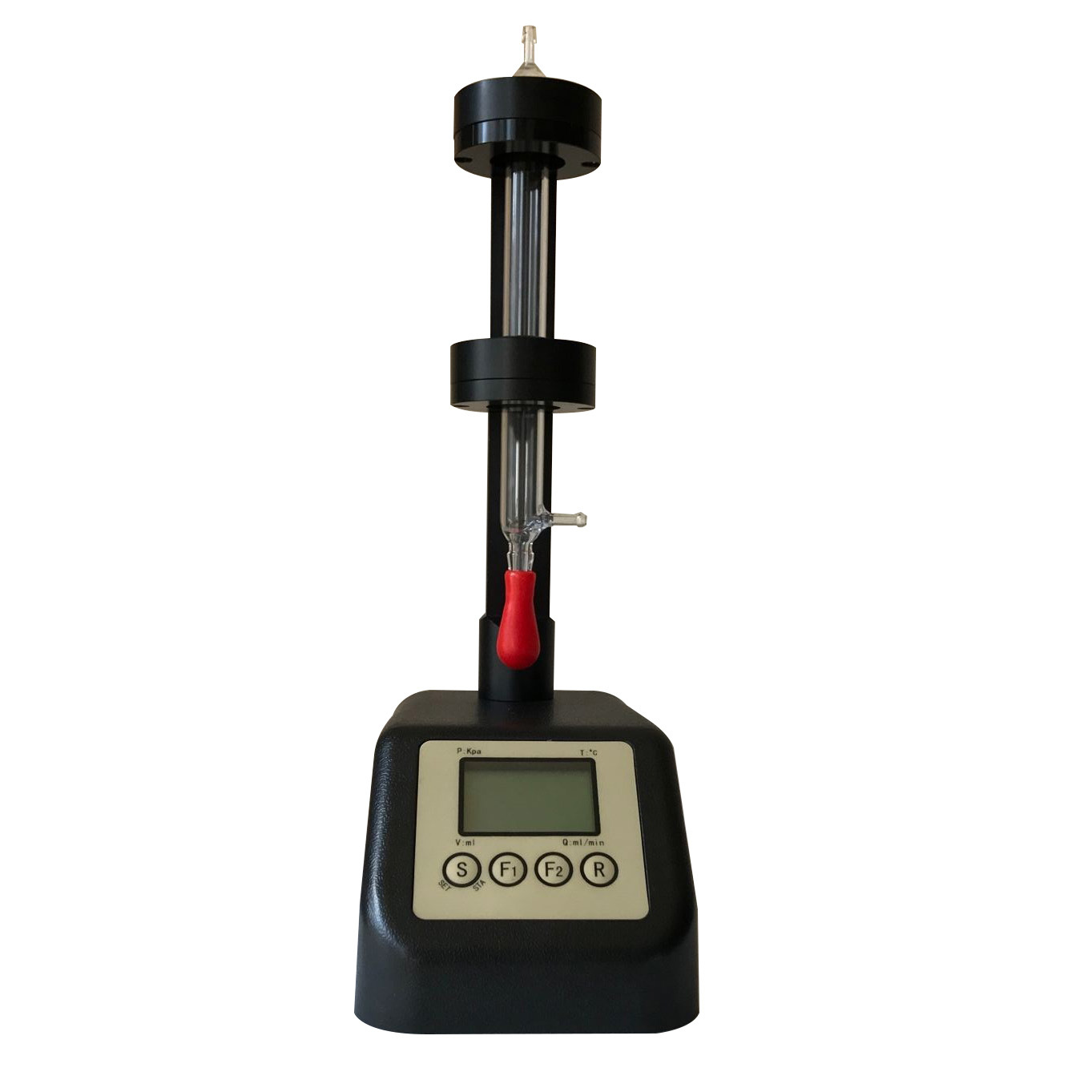We present the results of a laboratory experimental study of an internal wave
field generated by harmonic, spatially periodic boundary forcing from above of a
density stratification comprising a strongly stratified, thin upper layer sitting atop
a weakly stratified, deep lower layer. In linear regimes, the energy flux associated
with relatively high frequency internal waves excited in the upper layer is prevented
from entering the lower layer by virtue of evanescent decay of the wave field. In
the experiments, however, we find that the development of parametric subharmonic
instability in the upper layer transfers energy from the forced primary wave into a pair
of subharmonic daughter waves, each capable of penetrating the weakly stratified
lower layer. We find that around 10% of the primary wave energy flux penetrates
into the lower layer via this nonlinear wave-wave interaction for the regime we
study.
方案详情

PHYSICS OF FLUIDS 28, 011703 (2016) 011703-2 Ghaemsaidi et al.Phys. Fluids 28, 011703 (2016) S. J. Ghaemsaidi,1,a) S. Joubaud,2T. Dauxois,2 P. Odier.?and T. Peacock1'Department of Mechanical Engineering, Massachusetts Institute of Technology,Cambridge, Massachusetts 02139, USALaboratoire de Physique, Ecole Normale Superieure de Lyon, Universite de Lyon, CNRS,46 Allee d'Italie, F-69364 Lyon Cedex 07, France (Received 21 August 2015; accepted 24 November 2015; published online 13 January 2016) We present the results of a laboratory experimental study of an internal wavefield generated by harmonic, spatially periodic boundary forcing from above of adensity stratification comprising a strongly stratified, thin upper layer sitting atopa weakly stratified, deep lower layer. In linear regimes, the energy flux associatedwith relatively high frequency internal waves excited in the upper layer is preventedfrom entering the lower layer by virtue of evanescent decay of the wave field. Inthe experiments, however, we find that the development of parametric subharmonicinstability in the upper layer transfers energy from the forced primary wave into a pairof subharmonic daughter waves, each capable of penetrating the weakly stratifiedlower layer. We find that around 10% of the primary wave energy flux penetratesinto the lower layer via this nonlinear wave-wave interaction for the regime westudy. 2016 AIP Publishing LLC.[http://dx.doi.org/10.1063/1.4939001] Internal waves are prevalent in the oceans by virtue of gravitationally stable backgroundtemperature and salinity gradients. Typically, the oceanic water column is characterized by a mixedlayer of uniform density overlying a strongly stratified near-surface layer, beneath which lies theweakly stratified deep ocean. Of substantial interest, and a motivation for this study, is how internalwaves excited by motions in the mixed layer may penetrate into the deep ocean, where they maypotentially drive deep-ocean mixing.. There have been many studies regarding the propagation of linear internal wave fields throughnonuniform density stratifications, as characterized by the vertical variation of the local buoyancyfrequency N(z)=√(-8/p)dp/dz, where z is the coordinate aligned antiparallel with gravity gand p(z) is the background density profile. A standard procedure that provides substantial insightis to calculate the transmission properties through piecewise linear density gradients by matchingboundary conditions at interfaces. A notable advance on such methods was the development of ananalytical approach to tackle propagation through continuous stratifications without requiring anyassumptions regarding the relative scale of the waves and variations of the background stratifica-tion. This approach was subsequently extended to address the propagation of internal wave beamsthrough nonuniform stratifications,the predictions being validated by close agreement with labora-tory experiments. All the aforementioned examples being linear models, however, the propagatingwave field does not experience wave-wave interactions. It is well established that nonlinearities can give rise to wave-wave interactions and resonantgrowth via the so called parametric subharmonic instability (PSI).6-8 This process takes internalwave energy from a primary,“mother wave of frequency wo and wavenumber ko, and distributes itamong a pair of “daughterwaves offrequencies wi and w2, and wavenumbers k and k2, with therequirements that wi +w2=wo and k1+k2= ko. The subharmonic daughter waves birthed by PSIare characterized by smaller vertical length scales, and thus higher vertical shear, and slower groupvelocities. In light of this, field studies ,10 and numerical simulations1112 have sought to investigate ( a)Electronic mail: sjsaidi@mit.edu ) FIG. 1. Schematic of the experimental configuration. A sample particle image is overlaid to show the field of view capturedby the CCD camera. The measured buoyancy frequency profile N(z) is overlaid to the right. PSI driven processes to explore its potential to drive mixing processes in the ocean. Complementarylaboratory studies in uniform stratifications have demonstrated conditions under which internalwave fields become unstable to minute perturbations via PSI.13,14 In this letter, we present the results of a laboratory experiment in which internal waves areexcited in a relatively shallow, upper layer of high buoyancy frequency, Ni, sitting atop a deeperlayer of low buoyancy frequency, N2. The internal wave field is excited at a relatively high fre-quency wo (i.e., N2denote time period averaging. We note that the primary wave field is weakly nonlinear by virtue ofPSI taking place and that the aforementioned definitions neglect viscosity. Nevertheless, we utilizethis approach in order to obtain order of magnitude estimates of energy transmission. Figure 5 presents the power transmission profiles computed by separately applying the energyflux calculations to each of the downward propagating wave components presented in Figure 4. Asexpected,there is no power transmission of relatively high frequency waves (i.e., w> N2) into theweakly stratified lower layer. There is, however, notable power transmission for daughter waves atfrequency wi and some transmission at frequency w2. More quantitatively, we find that O(10%) ofthe power of the primary wave is transmitted in the form of the daughter wave of frequency wi,made possible by PSI, and O(1%) is transmitted at frequency w2. The subsequent decay of thispower with depth is attributable to viscous effects, which affect the daughter waves somewhat morethan the primary wave, due to the smaller length scales of the former compared to the latter. Weestimate the viscous dissipation of the vertical energy flux through the factor Over the pycnocline, the primary wave vertical energy flux decreases by approximately 5%, whilethe vertical energy flux of the wi- and w-daughter waves decrease by approximately 90% and 70%,respectively, over the entire stratification. As can be deduced from (3), wave fields characterizedby larger length scales experience less viscous decay, and therefore a reduced PSI threshold whichallows an even larger fraction of the primary wave energy to penetrate the weakly stratified lowerlayer. 011703-6 In summary, our experiments provide the first demonstration of a novel process by which en-ergy injected at relatively high frequencies into the strongly stratified upper-layer of a water columncan penetrate into an otherwise forbidden, weakly stratified lower-layer lying beneath. The under-lying mechanism is PSI, which extracts energy from the primary wave and distributes some of itinto a pair of daughter waves, both of which are not evanescent, but propagating, in the lower layer.Two elements contribute to the development of PSI in our system: the broad-envelope of forcing 19.20and the near-total reflection of energy at the base of the pycnocline.21 The consequent increase inthe amplitude of the primary wave field induces faster growth rates of the instability. At higherReynolds number and/or thinner pycnoclines, however, harmonic generation might diminish thePSI-driven transmission of wave energy into the lower layer. For the experimental configuration,we used to demonstrate this scenario, we found the development of PSI to have an O(10%) effectwith regards to power transmission, although more studies would be required to determine how thisvaries with the strength of the wave field, pycnocline thickness, and other system parameters such aswo, ko, Ni, and N2. Building on this discovery, in future studies, it would be of interest to investigatewhether this scenario might have relevance to the ocean, which is also characterized by a stronglystratified upper layer and a weakly stratified abyss. Physical processes, such as Langmuir circu-lation23,24 and shear-driven instabilities,25are known to excite relatively high-frequency internalwaves in the upper ocean but relatively little is known about the magnitude and fate of the energyflux associated with them. In order for PSI to manifest in the ocean, the forcing mechanism wouldeither have to be of large amplitude (since the growth rate of the instability is strongly dependenton the wave amplitudel4), or persist for a sufficient number of forcing periods on a well establishedtime scale. S.J.G. thanks the MIT-France Program for their support in establishing this collaboration. S.J.,T.D., and P.O. thank ONLITUR (No. ANR-2011-BS04-006-01). T.P. acknowledges the support ofthe NSF (No.OCE-1357434). ( W . Munk and C. Wunsch, “Abyssal recipes II: Energetics of tidal and wind mi x ing,”Dee p Sea Res., Pa r t I 45 , 197 7 -2010 ( 1998). ) ( C. Wunsch and R. Ferrari, “Vertical mixing, energy, and the general circulation of the oceans,”Annu . Rev. Fluid Mech. 36, 281-314(2004). ) ( B. R. Sutherland and K . Yewchuk,“I n ternal wave tunnelling,”J. F luid Mech. 5 11,12 5 -134(2004). ) 4J. T. Nault and B. R. Sutherland,“Internal wave transmission in nonuniform flows,”Phys. Fluids 19, 016601 (2007). ( M. Mathur and T. Peacock,“Internal wave beam propagation in n on-uniform stratifications,J. F luid M ech. 6 39, 133-152 ( 2009). ) ( R. P. Mied, “T h e occurrence of parametric instabilities in finite-amplitude internal gr a vity waves,”J. F l u i d Mec h . 78 , 763-784(1976). ) ( ' P . G. Drazin,“On the instability of an internal gravity wave," Proc. R. Soc. A 356,411-432(1977). ) ( C. R. Koudella and C. Staquet, “I n stability mechanisms of a two-dimensional progressive internal gra v ity wave,"J. Fl uid M ech. 5 48, 1 65-196 (2006). ) M. H. Alford,J. A. Mackinnon,Z. Zhao, R. Pinkel,J.Klymak, and T. Peacock, “Internal waves across the Pacific,"Geophys.Res. Lett. 34,L24601, doi:10.1029/2007GL031566(2007). ( 10 J. A. MacKinnon, M. H . A l ford, O. S u n, R. P i nkel, Z. Zhao, and J. Klymak, “Parametric subharmonic instability of the internal tid e at 29°N,” J . Phys . Oceanogr. 43, 17-28 (2013). ) ( J. A. M a cKinnon and K. B. Winters,“Subtropical catastrophe: Significant loss of low-mode tidal energy at 28.9°,Geoph ys. Res.Lett. 32, L15605, doi:10.1029/2005GL023376 (2005). ) 2 B. Gayen and S. Sarkar,“Degradation of an internal wave beam by parametric subharmonic instability in an upper oceanpycnocline,J.Geophys. Res.: Oceans 118, 4689-4698, doi:10.1002/jgrc.20321 (2013). ( 13 S. Joubaud, J .Munroe, P. Od i er, and T. D auxois,“Expe r imental paramet r ic subharmo n ic instability in stratif i ed fluids,” P h ys . F luids 2 4, 041703 (2012). ) ( 4B. B o urget, T. Dauxois, S. Joubaud, and P . O dier,“ E xperimental study of parametric s u bharmonic instability for internal p lane waves,"J . Fluid Mech. 723,1-20(2013). ) 15 P. Flandrin, Time-Frequency/Time-Scale Analysis (Academic, 1999). 16 M. J. Mercier, N. B. Garnier, and T. Dauxois,“Reflection and diffraction of internal waves analyzed with the Hilbert trans-form,”Phys. Fluids 20, 086601(2008). ( H. H. Ka r imi and T. R. Akylas, “Parametric subharmonic instability of internal waves: L o cally confined b e ams versusmonochromatic wavetrains," J. Flui d Mech . 757,381-402 (2014). ) 20 B. Bourget, H. Scolan, T. Dauxois, M. Le Bars, P. Odier, and S. Joubaud, “Finite-size effects in parametric subharmonicinstability,"J. Fluid Mech. 759,739-750(2014). Q. Zhou and P. J. Diamessis,“Reflection of an internal gravity wave beam off a horizontal free-slip surface, Phys. Fluids25,036601(2013). 22 P. J. Diamessis, S. Wunsch, I. Delwiche, and M. P. Richter,“Nonlinear generation of harmonics through the interaction ofan internal wave beam with a model oceanic pycnocline,"Dyn. Atmos.Oceans 66,110-137(2014). 23S. Thorpe, “Langmuir circulation,” Annu. Rev. Fluid Mech.36,55-79(2004). 24 J. A. Polton,J. A. Smith,J. A. MacKinnon, and A. E. Tejada-Martínez,“Rapid generation of high-frequency internal wavesbeneath a wind and wave forced oceanic surface mixed layer,"Geophys.Res. Lett. 35,L13602,doi:10.1029/2008GL033856(2008). 25 H. T. Pham, S. Sarkar, and K. A. Brucker,“Dynamics of a stratified shear layer above a region of uniform stratification,"J. Fluid Mech. 630, 191-223(2009). /$ AIP Publishing LLCThis article is copyrighted as indicated in the article. Reuse of AIP content is subject to the terms at: http://scitation.aip.org/termsconditions. Downloadedto IP:On: Thu, Jan
确定

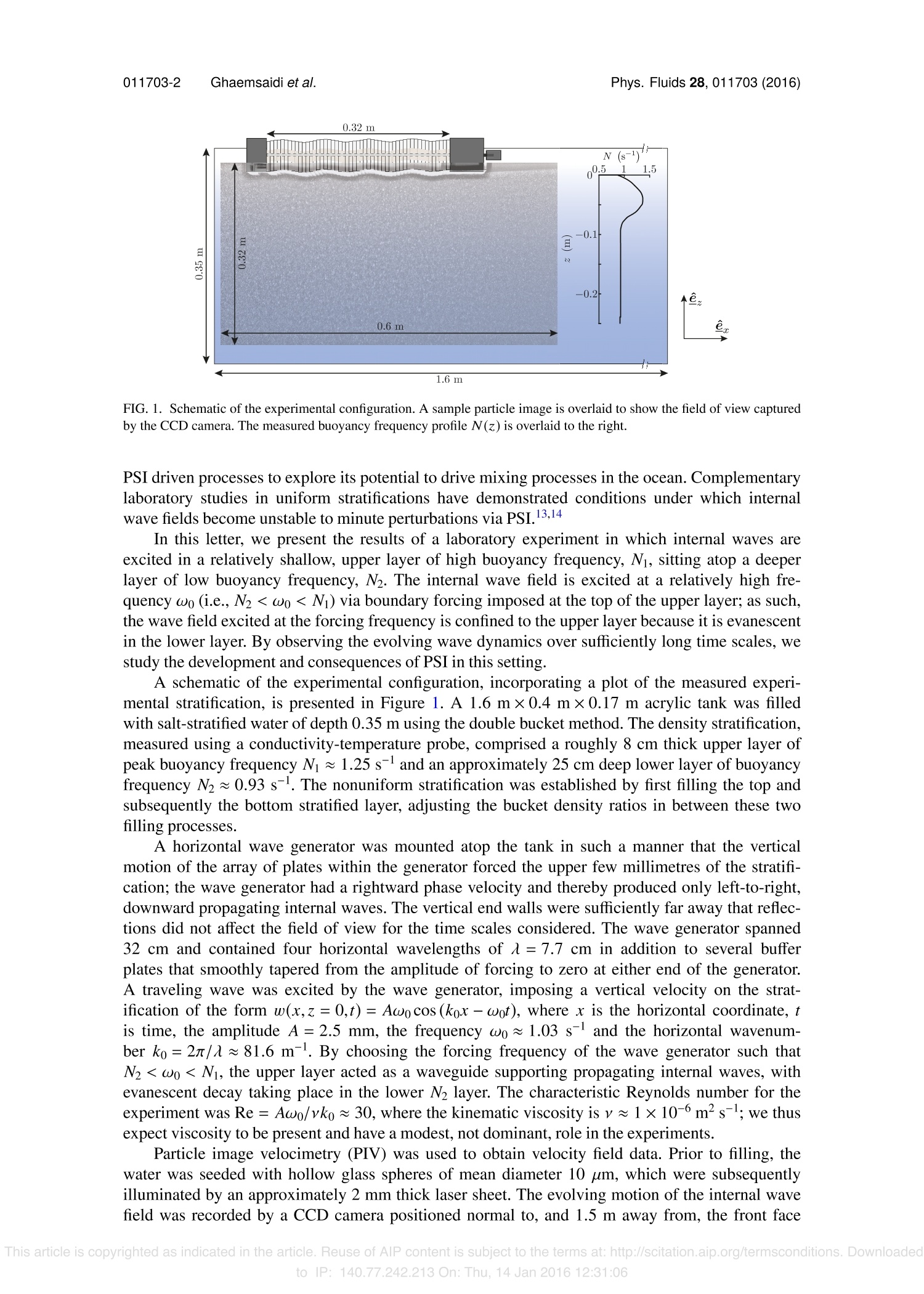
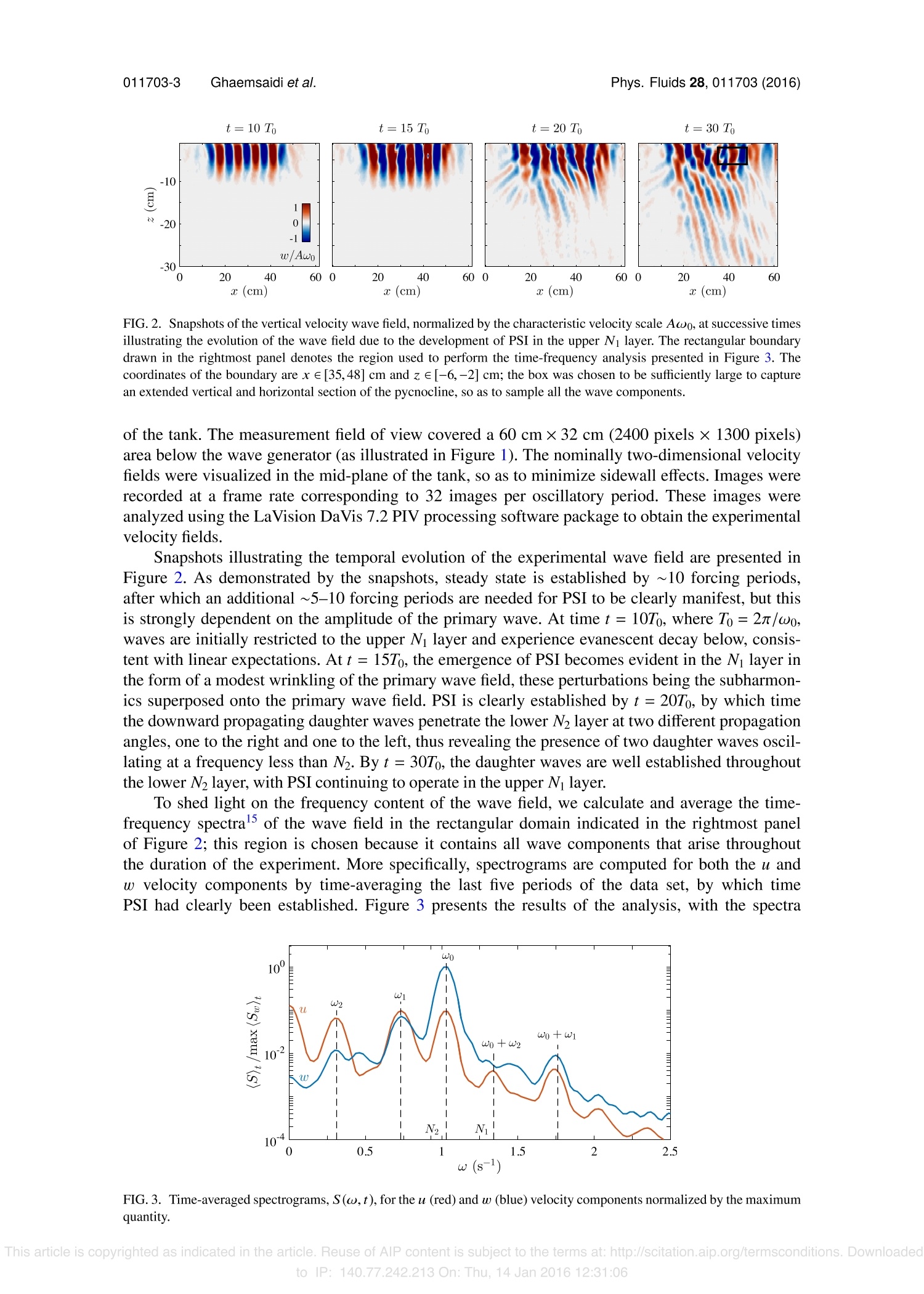
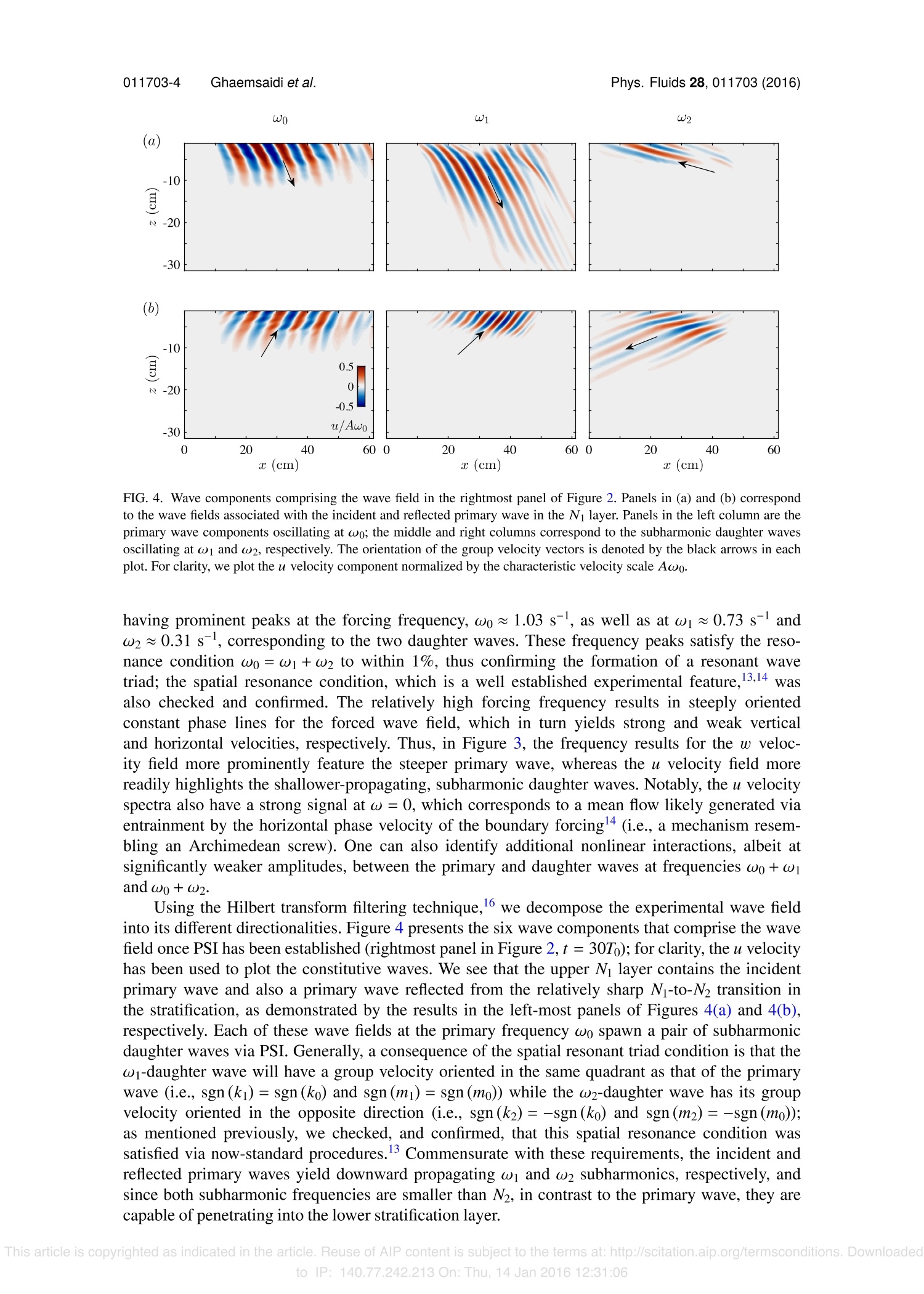
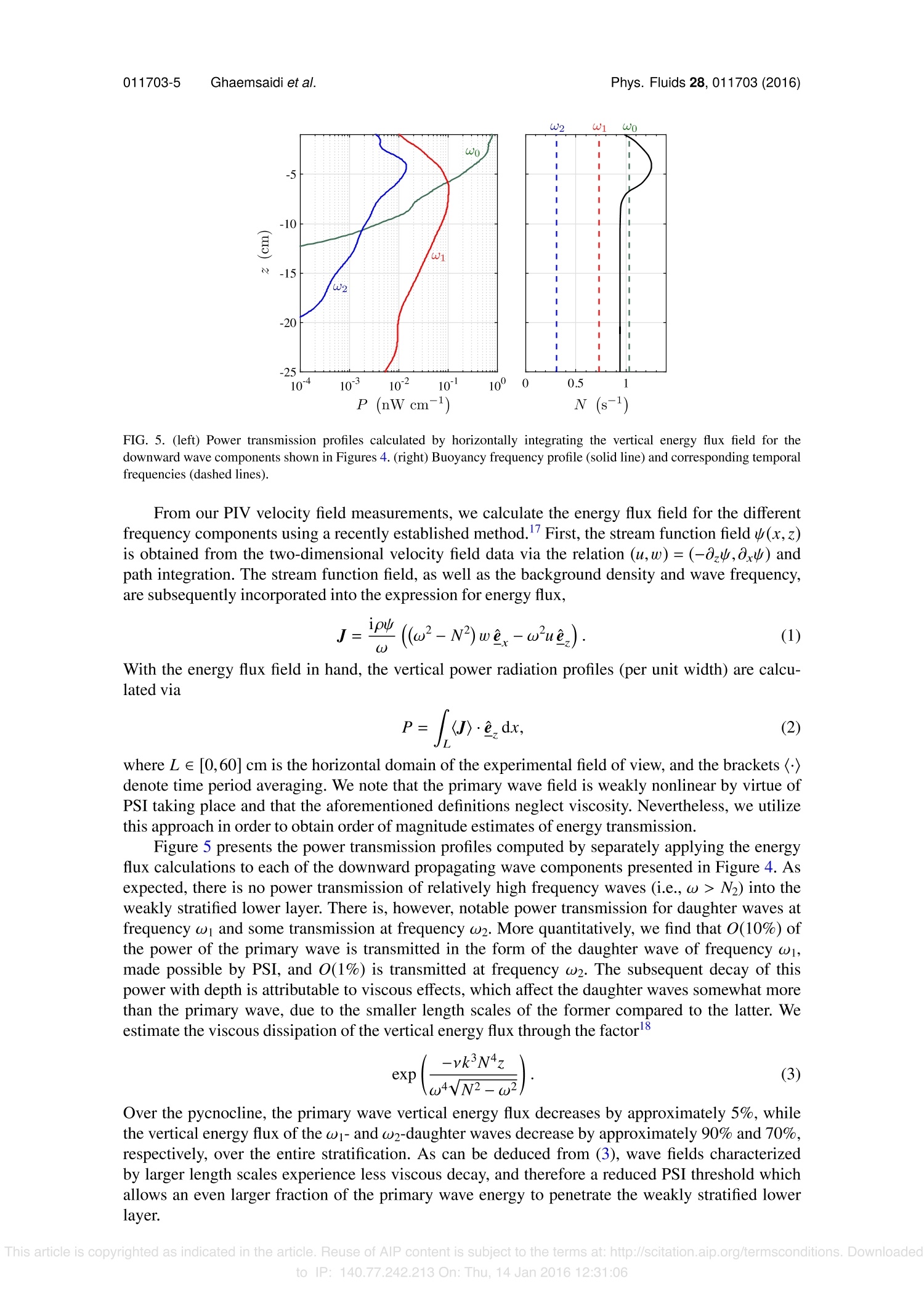


还剩5页未读,是否继续阅读?
北京欧兰科技发展有限公司为您提供《非线性内波中通过参量亚谐波不稳定性的穿透检测方案(粒子图像测速)》,该方案主要用于其他中通过参量亚谐波不稳定性的穿透检测,参考标准--,《非线性内波中通过参量亚谐波不稳定性的穿透检测方案(粒子图像测速)》用到的仪器有德国LaVision PIV/PLIF粒子成像测速场仪、Imager sCMOS PIV相机、PLIF平面激光诱导荧光火焰燃烧检测系统
推荐专场
CCD相机/影像CCD
更多
相关方案
更多
该厂商其他方案
更多























